This article is from a talk I gave about antenna traps. It contains measurements of traps, performance of trap antennas using models of traps, and ideas on how to make trap antennas more efficient.
Try taking this Trap-Q test! Be honest.
1.)
Is
it best
to make the trap resonant close to the desired operating frequency?
2.)
Does bandwidth decrease with increasing trap Q?
3.)
Do traps create noticeable loss, perhaps one dB per trap
typically?
4.) Does higher trap operating Q always mean lower loss?
Coaxial Trap Designer by VE6YP (Tony Fields)
(I do not warrant the actual program. I only offer measurements compared to the program results.)
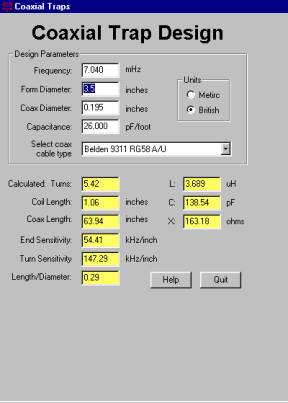
This is a good program to get you in the ballpark with a trap design. It was available as freeware. (Unfortunately coaxial traps are relatively lossy on the trapped frequency compared to other types.)
The software is available at http://www.qsl.net/ve6yp/
7.04
MHz
3.5 inch diameter form
RG58/U into the VE6YP program yields calculated values of:
Calculated
Actual
Measurement
L=
3.689mH
3.116mH
C=
138.5 pF
164 pF
64
inches
59 inches
Using
the
program TLA
by N6BV (from ARRL), we would
estimate capacitance of a 59" RG-58/U cable as:
Measuring a real-world stub, capacitance was 164pF (Q=590).
While that Q seems high, remember a typical transmitting-type air-variable capacitor has a Q of several thousand!
Coaxial
Trap Articles and Programs use capacitance/ft multiplied times length….
26
pF * 4.917 feet
= 127.84 pF in trap program
C164
pF measured. This error,
36pF low from 164pF, occurs because the transmission line making up the "coaxial
capacitor" is not actually treated as a transmission line in the modeling
program.
Fortunately the error is in a useful direction, because we can shorten the cable! Coaxial capacitors are really open stubs, and should be treated that way once they are more than a few degrees long.
CONCLUSION: The difference between TLA and an actual measurement was around 4%. This is very close, but the result has significant difference from the coaxial trap program since it only considers pF per foot as the capacitance. A longer cable (in fraction of a wavelength) results in greater error by using pF per foot. The error comes because a coaxial cable capacitor is really a stub, NOT a pure capacitor!!
Trap
Measurements (at resonance)
|
Type |
F
MHz |
R
parallel |
X |
|
Coax
RG-58 |
7.034 |
17,800 |
0 |
|
UT-141-75
semi-rigid |
7.045 |
45,330 |
0 |
|
100pF
7.5kV & #12 wire |
7.040 |
99,850 |
0 |
|
60pF
15 kV & #10 wire |
7.040 |
250,000 |
0 |
|
60
pF vac & Copper tubing |
7.040 |
300,000 |
0 |
|
Coax
RG-58 |
3.700 |
23,200 |
0 |
|
Coaxial
with fixed mica capacitor |
7.040 |
21,660 |
0 |
Highest
R parallel equivalent is best!!
Lower Rp means more loss.
Trap
Measurement summary:
-
Coaxial trap poorest
-
Once #10AWG wire is used, not much improvement
-
Space-wound bare wire makes best inductor
-
Transmitting-type capacitors noticeably better than capacitors made from coax
10 Meter (Tribander) Traps
|
Type |
Freq |
R
parallel |
X |
|
Coax
RG-58 |
29.00 |
13,800 |
0 |
|
Mosley
TA-33 |
30.64 |
43,100 |
0 |
|
Mosley
Pro-57 |
27.46 |
66,080 |
0 |
|
Cushcraft
A3 |
28.78 |
110,000 |
0 |
|
HyGain
TH-3 |
29.67 |
140,200 |
0 |
Traps are not all that bad when you plug them into models.
15 Meter
(Tribander) Traps
|
Type |
Freq |
R
parallel |
X |
|
Coax
RG-58 |
21.00 |
13,980 |
0 |
|
Cushcraft
A3 |
21.43 |
76,270 |
0 |
|
Mosley
TA-33 |
21.68 |
79,000 |
0 |
|
HyGain
TH-6 |
22.23 |
142,000 |
0 |
Trap Model
R
L
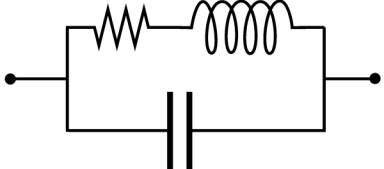
C
Measured Values Coax 7 MHz Trap
|
Freq |
Imp |
R |
Xc |
Q
|
L
uH |
C
pF |
|
7.04 |
17,800
j0 |
1.03 |
138 |
134 |
3.114 |
164 |
|
3.7 |
1.1
j 97 |
.6 |
283 |
88 |
3.114 |
152 |
Measured Values L/C 7 MHz Trap
|
Freq |
Imp |
R |
Xc |
Q |
L
uH |
C
pF |
|
7.04 |
99,850
j0 |
.36 |
215 |
465 |
4.92 |
105 |
|
3.7 |
0.53 j
156 |
.25 |
409 |
294 |
4.92 |
105 |
SWR Bandwidth
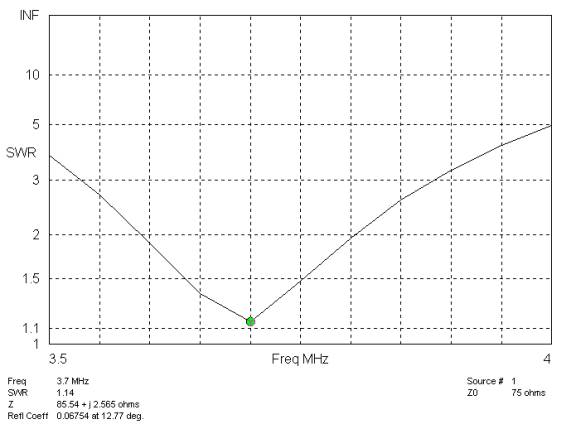
7
MHz RG-58 TRAP
80 m 75 ohm VSWR
EZNEC
#12AWG
dipole
Coax trap 80m 2:1 VSWR ~210 kHz
Total trap loss = 0.05 dB
RG-58 TRAP, 75 ohm VSWR, 40 METERS
VSWR
BW
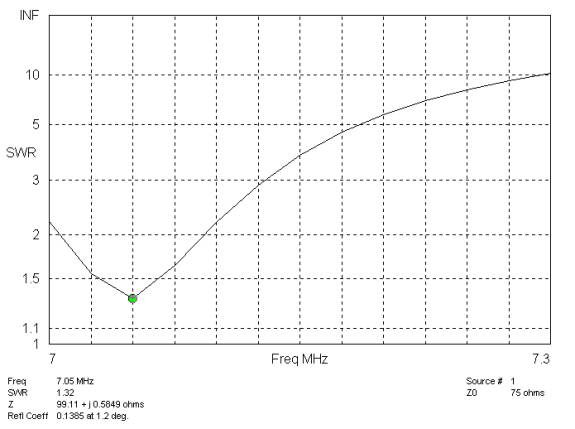
Coax
trap 40 meter 2:1 VSWR ~ 80 kHz
Total coaxial trap loss at resonance on 40m= 1.6 dB
Total
coaxial trap loss 100kHz off-resonance (at 7.15 MHz)= 1.06 dB
Note that loss is maximum at trap resonance!!!
Never make a trap resonant on the desired operating frequency!!
W2LH ARRL Handbook Trap Design
100pF #12awg Miniductor trap
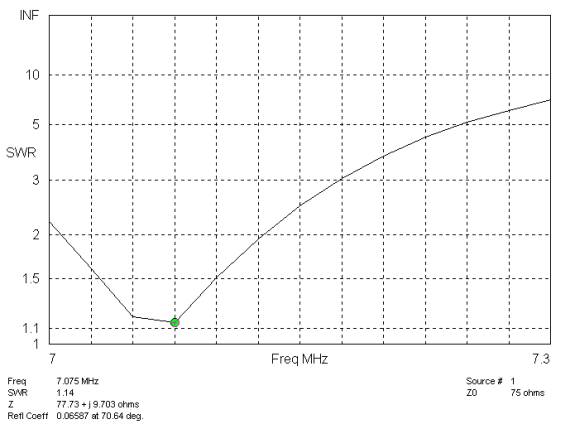
40m 2:1 VSWR
~120 kHz
Total loss = 0.24 dB
W2LH
ARRL HANDBOOK TRAP 80m VSWR
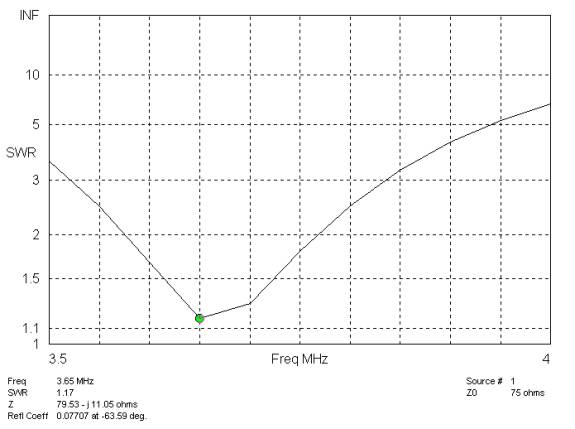
80m
2:1 VSWR
BW ~ 200 kHz
Total trap loss = 0.026 dB
What
happens if trap is not in band?
VSWR Bandwidth
of 6.51MHz trap in 80/40 dipole
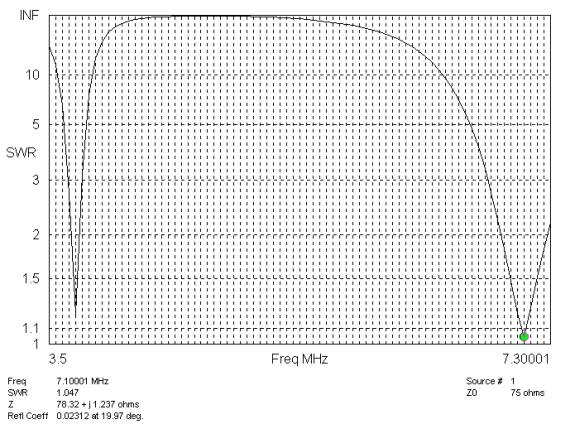
Trap at 6.51 MHz Q=130
Loss at 7.15 MHz
= 0.314 dB
Loss at 3.7 MHz = 0.324 dB
This is a 104-foot long antenna, with very poor Q traps, and loss is less than .4dB! The reason loss is low is we have moved the trap slightly out-of-band.
6.15 MHz Q=130
TRAP 40m VSWR
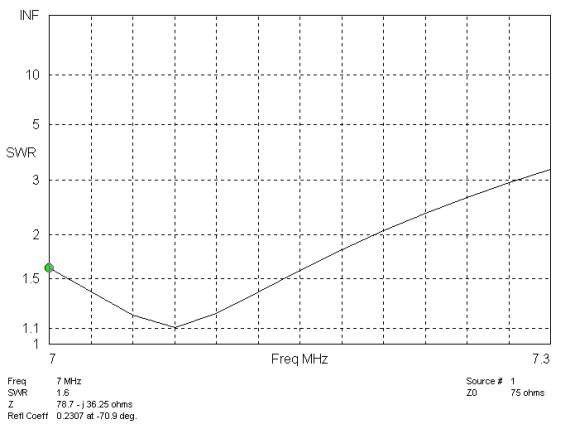
7
MHz 2:1 VSWR BANDWIDTH ~200kHz
Trap
Q at resonance = 130
7 MHz loss ~ .3 dB
6.15 MHz Q=130 TRAP 80m VSWR
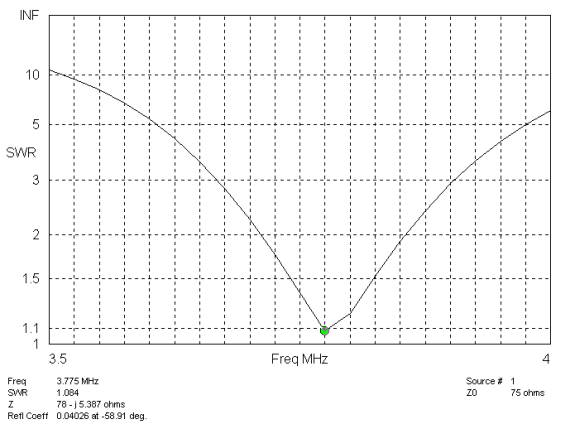
80M 2:1 VSWR BW ~130 kHz
Loss at 3.7 MHz = 0.324 dB
1.) Is it best to make the trap resonant close to the desired operating frequency?
NO!
Loss is highest when the trap is resonant at the operating frequency!
2.) Does bandwidth decrease with increasing trap Q?
NO! Bandwidth is a function of many variables, trap Q actually has one of the smallest influences on BW.
3.) Do traps create noticeable loss, perhaps one dB per trap typically?
NO! Even the worse traps (coaxial traps) in the worse possible condition of operation are only 1.6dB loss for BOTH traps!
4.) Does higher trap operating Q always mean lower loss?
NO! Loss depends on many factors, including trap resonant frequency.
Conclusions:
-
Trap loss has been greatly exaggerated by advertising hype
-
Traps should not be resonant at the actual planned operating frequency
-
Coaxial traps are more lossy than articles conclude
-
Coaxial stubs used as capacitors can not be calculated using pF/ft unless the stub is a very small fraction of a wavelength long (less than a few electrical degrees)
-
Coaxial stubs have low Q (are relatively lossy) compared to normal lumped components.